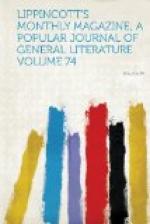[Illustration: Cold saw.]
The bloom is now re-heated and subjected to the process of rolling. “The rolls” are heavy cylinders of cast iron placed almost in contact, and revolving rapidly by steam-power. The bloom is caught between these rollers, and passed backward and forward until it is pressed into a flat bar, averaging from four to six inches in width, and about an inch and a half thick. These bars are then cut into short lengths, piled, heated again in a furnace, and re-rolled. After going through this process they form the bar iron of commerce. From the iron reduced into this form the various parts used in the construction of iron bridges are made by being rolled into shape, the rolls through which the various parts pass having grooves of the form it is desired to give to the pieces.
[Illustration: Hot saw.]
[Illustration: Riveting A column.]
These rolls, when they are driven by steam, obtain this generally from a boiler placed over the heating-or puddling-furnace, and heated by the waste gases from the furnace. This arrangement was first made by John Griffin, the superintendent of the Phoenix Iron-works, under whose direction the first rolled iron beams over nine inches thick that were ever made were produced at these works. The process of rolling toughens the iron, seeming to draw out its fibres; and iron that has been twice rolled is considered fit for ordinary uses. For the various parts of a bridge, however, where great toughness and tensile strength are necessary, as well as uniformity of texture, the iron is rolled a third time. The bars are therefore cut again into pieces, piled, re-heated and rolled again. A bar of iron which has been rolled twice is formed from a pile of fourteen separate pieces of iron that have been rolled only once, or “muck bar,” as it is called; while the thrice-rolled bar is made from a pile of eight separate pieces of double-rolled iron. If, therefore, one of the original pieces of iron has any flaw or defect, it will form only a hundred and twelfth part of the thrice-rolled bar. The uniformity of texture and the toughness of the bars which have been thrice rolled are so great that they may be twisted, cold, into a knot without showing any signs of fracture. The bars of iron, whether hot or cold, are sawn to the various required lengths by the hot or cold saws shown in the illustrations, which revolve with great rapidity.
[Illustration: Furnace and hydraulic die.]
For the columns intended to sustain the compressive thrust of heavy weights a form is used in this establishment of their own design, and to which the name of the “Phoenix column” has been given. They are tubes made from four or from eight sections rolled in the usual way and riveted together at their flanges. When necessary, such columns are joined together by cast-iron joint-blocks, with circular tenons which fit into the hollows of each tube.




